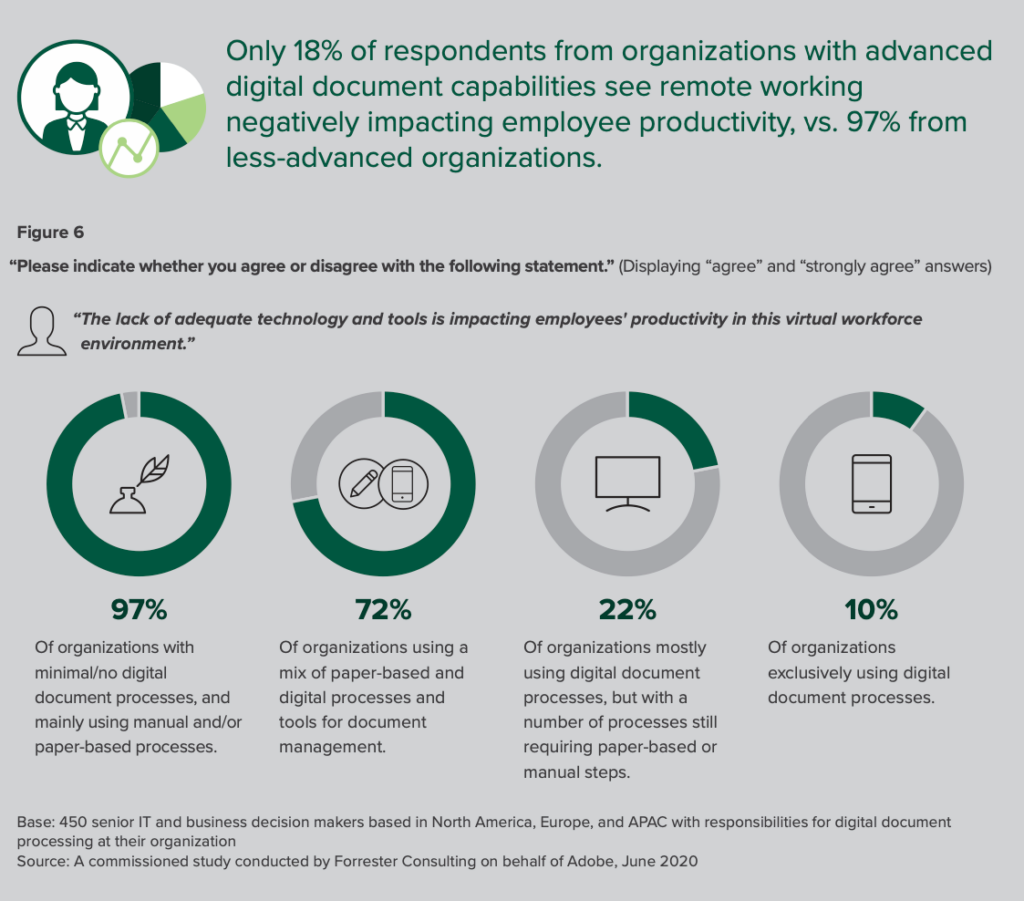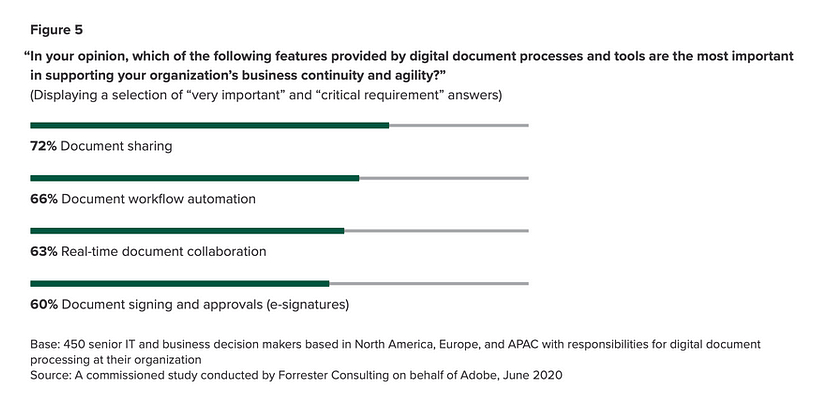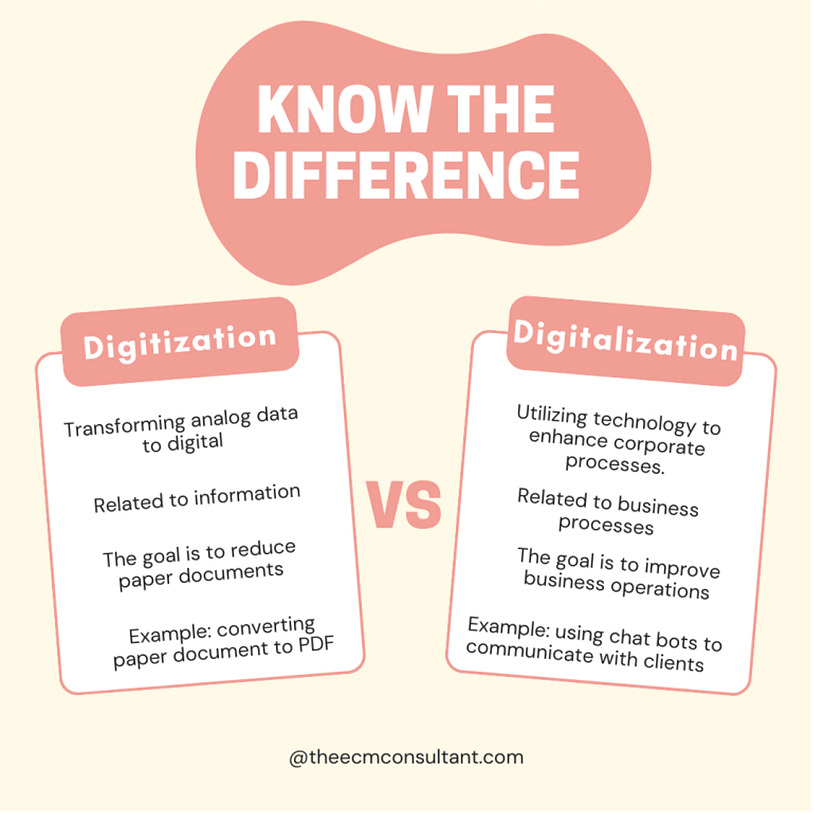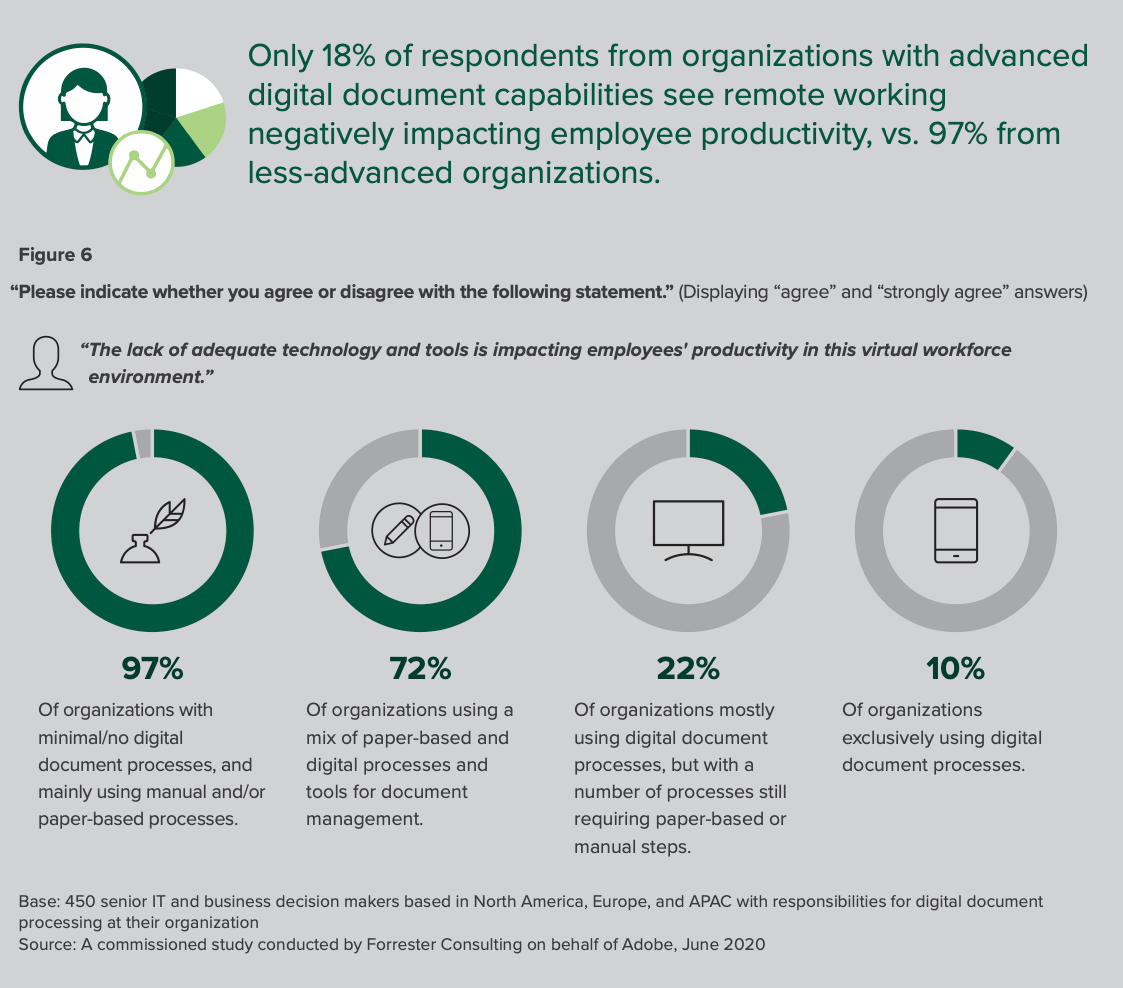State of the industries; How we got here
If we have learned anything from the start of the 2020s, it is that when disruptive conditions challenge the way we work, our business processes and data must be exceptionally agile to adapt. Our New Way of Working has demonstrated that remote workforces are sustainable. However remote isn’t just working from home – it’s in satellite offices, airports, cafes, and beaches. Full filing cabinets and massive off-site storage of documents are ineffective in supporting the needs of today’s workforce. Document digitization, on the other hand, empowers your organization to access data faster and with greater efficiency. The push toward a digital transformation has never been as strong as it is today.
Many businesses are turning to document digitization as a means to fortify their processes to weather future uncertainty. While some organizations have been able to implement digital solutions, there are entire industries that have struggled to innovate their paper-heavy processes. This is becoming problematic in today’s business environment because paper is inefficient for the transmission of information, it is costly to store, retrieve, and process, it is not inherently secure, and it’s bad for the environment. Becoming a paperless office is no longer optional.
By the numbers (why digitization matters)
Just how much time is wasted searching for information? Studies show that employee productivity can be negatively impacted by as much as 25% due to document issues. Further, it is estimated that 7.5% of all paper documents get lost; time spent searching for missing documents can never be recovered. When documents are misplaced, 83% of employees will recreate the missing document if they can’t find them in their organization’s repository. This leads to multiple versions of the same document existing in physical or digital form as well as an unnecessary duplication of work.
A Forrester Consulting report commissioned by Adobe recently qualified how detrimental the lack of adequate digital tools had on employees. The report revealed that 97% of organizations with minimal or no digital document processes, and 72% using a mix of paper-based and digital processes, agreed that productivity was suffering. The lack of comprehensive, streamlined digital document processes, was causing organizations to lose critical time while maintaining, retrieving, and processing documents.

CORP! Magazine published a statistic stating that American organizations waste a total of $8 billion managing paper every year. They estimate the realized costs per document break down to the following:
- $20 to file a document
- $120 to find a misplaced document
- $220 to reproduce a lost document
Missing documents also put your organization’s professional reputation and licensure at risk. Organizations that operate under heavy state and federal regulation, understand the importance of compliance audit preparedness, and the risk of significant fines for improperly managed or lost documents. The ability to locate and retrieve documents in a timely manner for audits and compliance evaluations is absolutely critical.
Improved productivity and compliance may appeal to some organizations, but what about the environmental impact? Paper-driven workflows dominate operations, such as accounting, billing, human resources, and customer service, and only work against green initiatives without a digital solution. According to an analysis by St. Charles County of Missouri, approximately 1 billion trees’ worth of paper is thrown away in the US, every year. The World Counts estimates that 26% of waste that ends up in landfill sites is discarded paper and paperboard.
With increasing importance placed on green initiatives, sustainability, compliance, sensitive data management, and work optimization, a digital document management system is a requirement for operating in today’s business environment. It has become clear that paper simply does not work any longer.
Define digitization, digitalization, digital transformation
Digital transformation is everything the future promises us when thinking about the transformative impact technology can affect on an organization. It represents a comprehensive change to an organization’s business strategy and dramatically improves business performance. In short, digital transformation is all about the application of technologies to empower people, optimize workflows, and automate systems across the entire organization.
In its simplest definition, digitization means digitizing data; it is the process of making information available and accessible in a digital format. Your organization may already be performing rudimentary digitization of documents for Accounting, HR, and other internal processes, by scanning analog documents into an image format to support manual data entry into business systems. In the modern context, digitization is more than just capturing a digital image of a paper document for retention and transcription. Today, traditional Optical Character Recognition (OCR) is being infused with advanced technologies, such as intelligent capture and machine learning, are to turn paper documents into fully-searchable files. This is an important first step towards a digital transformation of your organization. Having documents stored digitally harden business continuity processes and improves overall organizational agility to respond to changing conditions. A recently commissioned study conducted by Forrester Consulting on behalf of Adobe revealed that a large majority of business decision-makers rated the following digital document features as very important and critical:

While digitization relates to the storage of information, digitalization is leveraging digital information to enhance business processes. As Gartner defines it, digitalization is the use of digital technologies to change a business model and provide new revenue and value-producing opportunities; it is the process of moving to a digital business. Digitalization relies on advanced capture engines and algorithms to extract information from digitized documents and pass it to business systems in the form of metadata with little to no human intervention. Beyond making existing data digital, digitalization employs technology to collect data, establish trends, and influence better business decision-making. Digitization and digitalization go hand in hand to drive agility and performance improvement to fuel the digital transformation of organizations.

(source: https://theecmconsultant.com/digitization-vs-digitalization/)
What’s the difference structured / unstructured documents
Many organizations have begun looking at document digitization solutions to simplify and automate data entry processes for specific workflows and projects. While digitization systems have been implemented by organizations in practically every industry, most of those systems are typically focused on the processing of structured documents, or documents that are organized in a well-defined, standardized format. Some examples of structured documents include:
- Patient Questionnaires
- Prescription refills
- Payment slips
- Insurance claims
- Financial applications
Unstructured documents do not have a defined structure. The general organization of these documents, even within the same classification, may vary significantly from one document to the next. Unstructured documents cannot be digitized with traditional Optical Character Resolution (OCR) systems because there is no consistent location within a document to point the capture engine to look at. In addition, unexpected markup within detection zones of OCR systems may be captured resulting in miskeyed information. Some examples of unstructured documents include:
- Letters
- Contracts
- Memos
- Invoices
- Purchase orders
- Explanations of benefits
Differentiating ICR and OCR
What makes Optical Character Recognition (OCR) and Intelligent Character Recognition (ICR) distinct may seem irrelevant to your organization, and even confusing. Though they are quite similar, the differences in capabilities are significant when these technologies are paired with document-scanning equipment and content management systems. OCR translates scanned images containing text into readable digital documents, though the technology is limited to typewritten and printed text. OCR works best for structured documents because the system must be trained to look in certain areas of a document for the data it needs to detect. OCR is not designed to recognize handwriting, and that is where ICR technology excels.
An ICR system focuses on handwriting and learns to recognize patterns to improve its overall accuracy of the capture over time. In its most mature iteration, ICR systems are deployed as a suite of capture engines and paired with machine learning algorithms in what is referred to as intelligent document processing. Where ICR shines is in the processing of unstructured documents because the capture examines the entire document for specific patterns in the text to detect relevant data to capture.
Why is digitization important to your organization
If the majority of your internal workflows are still paper-based, you’ve probably experienced productivity loss and the frustrations of misplaced documents first-hand. Embarking on a digital transformation journey is the path to efficiency and reduced costs in our current business environment.
From digital mail solutions to enterprise content management systems to integrations with business processing systems, document digitization provides the technical infrastructure needed to develop and implement workflow automation.
Digitized documents are easy to store, retrieve, and process while reducing overhead costs associated with handling physical documents. Robust document management solutions are secured with encryption, audit trails, and retention policies that help your organization maintain compliance with HIPAA, FINRA, and SEC standards.
Physical documents are not easily sharable, are costly to store, contribute to movement waste, are not inherently secure from accidental disclosure of sensitive information or improper destruction, and are bad for the environment. Off-site document storage provides a convenient method to reduce space allocated to the storage of documents while providing security for sensitive information. However, retrieval comes at a price every time a box is touched or moved. When boxes are delivered, your staff must then sink time into manually searching through the physical files to locate the information they need for their task.
In summary, a document digitization service empowers your business to access information faster, decreases the risk of lost or misplaced files, reduces overhead costs, and helps optimize and automate your business processes.
SOURCE CONTENT

